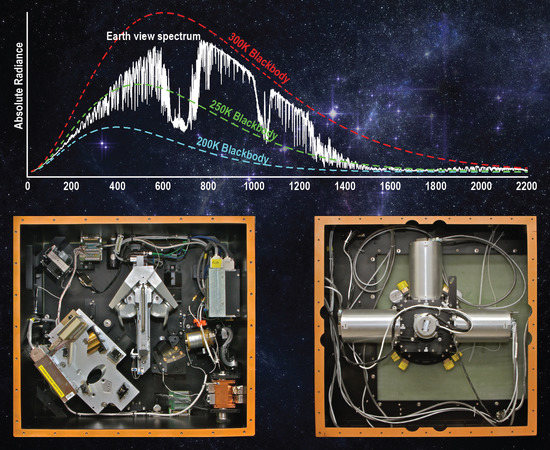The Infrared Absolute Radiance Interferometer (ARI) for CLARREO
Abstract
:1. Introduction
2. CLARREO
3. The Absolute Radiance Interferometer (ARI)
4. The Calibrated Fourier Transform Spectrometer (CFTS)
4.1. Design and Overview
- Ultra-high accuracy blackbody calibration reference source(s). During laboratory and vacuum testing two calibration references are required, while a single onboard calibration reference and a deep-space view are used for flight;
- A scene selection mirror assembly;
- A fore-optics telescope designed specifically for high radiometric accuracy;
- A 4-port cube-corner, rocking arm interferometer with a fiber-coupled diode laser-based metrology system;
- Two aft optics assemblies, 1 at each output port of the interferometer;
- A 77 K multiple semi-conductor detector (450–2000 cm−1) and dewar assembly;
- A very small mechanical cooler for the semi-conductor detector and dewar subassembly;
- A DTGS (deuterated triglycine sulfate) pyroelectric detector (200–1400 cm−1) assembly.
4.1.1. Key Trade-Studies
4.1.2. The Interferometer Modulator
- The beam splitter substrate and coatings have been replaced with materials that maximize efficiency over the 3–50 μm range (CsI beam splitter, modified production coating);
- Mounting of the beam splitter has been optimized for CsI material properties;
- A self-compensated beam splitter design is used instead of a substrate and compensator design;
- GICS utilizes a 4-port configuration while GFI uses a 2-port configuration;
- Laser metrology components have been relocated for compatibility with 4-port operation;
- Replicated monolithic cube-corners are used in the GICS;
- Due to cost considerations, the GFI flight electronics were replaced with modified commercial electronics and software for the IIP demonstration.
4.1.3. Fore and Aft Optics
- Optimization of interferometer throughput;
- Maximal stray light control;
- Minimization of instrument mass and volume;
- Optimization of the heated halo geometrical fill factor;
- Compatibility with a 1” aperture Blackbody;
- Capability for tuning of polarization sensitivity “null” locations with respect to the position of the calibration reference bodies, OARS, and scene views.
4.1.4. Detector Modules
4.2. Radiometric Calibration and Uncertainty
4.3. Predicted Uncertainty
4.3.1. Predicted Uncertainty: On-orbit
4.3.2. Predicted Uncertainty: Laboratory Testing
- Increased uncertainty associated with a cold blackbody reference compared to that of a space view. A true space view has no reflected radiance or emissivity uncertainty contributions;
- Increased uncertainty associated with the emissivity of OARS verification blackbody. For the on-orbit analysis, it was assumed that the OARS emissivity and associated uncertainty is determined from laboratory testing with a very high emissivity source, resulting in reduced emissivity uncertainty for the OARS with increasing wavenumber (* eOARS = 0.999 ± 0.0006 (200 cm−1), ±0.0004 (800 cm−1), ±0.0002 (1400 cm−1), ±0.0001 (2000 cm−1)). This characterization is outside the scope of the prototype demonstration;
- Increased uncertainty due to nonlinearity. The effective brightness temperature of the calibration references for the on-orbit configuration bracket much of the expected range of the scene equivalent brightness temperature. As the temperature separation between the calibration reference blackbodies decreases, the range of scene temperatures outside of the blackbody reference temperatures increases, and the calibration equation becomes much more sensitive to extrapolation error which in turn compounds errors due to uncorrected nonlinearity in the detector signal chain.
4.3.3. Predicted Uncertainty: Vacuum Testing
- Increased uncertainty associated with a blackbody compared to that of a space view;
- Increased uncertainty associated with the emissivity of OARS verification blackbody. As noted previously, for the on-orbit analysis, it was assumed that the OARS emissivity and associated uncertainty will be determined from laboratory testing with a very high emissivity source, resulting in reduced emissivity uncertainty for the OARS with increasing wavenumber (* eOARS = 0.999 ± 0.0006 (200 cm−1), ±0.0004 (800 cm−1), ±0.0002 (1400 cm−1), ±0.0001 (2000 cm−1)). This characterization is outside the scope of the prototype demonstration.
- Heat transfer conditions for the vacuum configuration are more representative of those associated with the on-orbit environment. Convection effects are significant in the laboratory environment and not present under vacuum. Increased convection results in slightly higher cavity temperature uniformity uncertainty for the calibration references in the laboratory environment, as indicated in Table 4. Since the impact is small (5 mK), a temperature uncertainty of 0.045 K for the ARI calibration sources and the OARS was used for the radiometric uncertainty analysis for all environments;
- Operation under vacuum provides complete mitigation of atmospheric absorption providing a clear assessment of the radiometric performance uncontaminated by atmospheric absorption and emission features;
- A second OARS was fabricated for vacuum testing, which was used as a cold reference blackbody. Since there are no dewpoint concerns for vacuum testing, the OARS and cold reference blackbody could be operated at the cold setpoint limit of the blackbody controllers and the recirculating chillers. This provided not only an extended range of calibration verification temperatures, but more importantly, the reference blackbody temperature configuration is closer to the on-orbit configuration. The extended range of operation of the OARS and cold reference blackbody under vacuum conditions is +60 °C to −60 °C, with a stability of better than 5 mK over 24 h (k = 3).
4.4. Radiometric Calibration Verification Results
5. The On-Orbit Verification and Test System (OVTS)
5.1. On-Orbit Absolute Radiance Standard (OARS)
5.1.1. OARS Temperature Calibration
5.1.2. OARS Spectral Emissivity Measurement
5.2. Blackbody Cavity Emissivity and Instrument Line Shape Measurement Using a Quantum Cascade Laser
5.3. Other OVTS Capabilities
5.4. Concept of Operations Employing Climate Measurements With on-Orbit Verification
6. Radiance Intercalibration Traceability for Improving the Accuracy of Operational IR Sounding Instruments
6.1. The Need for Improved Infrared Observation Calibration Accuracy via Intercalibration with a Reference Sensor
6.2. CLARREO Observational Requirements and Its Ability to Serve as an Infrared Intercalibration Reference
7. Conclusions
- The scientific value and societal benefits of spectrally resolved Earth emission spectrum measurements with ultra-high and proven accuracy have been well established by the NASA CLARREO Science Definition Team and related activities. Wielicki et al. [15] have shown that both emitted radiative trends and trends in temperature and water vapor distributions can be quantified at close to the observing limit set by natural variability using the type of measurements defined here, and that a series of this type of SI-based benchmark measurements will help limit the uncertainty of climate models. Both the information content and the accuracy significantly exceed that of current and planned total broadband climate observations including the Libera mission, recently selected by NASA under its new Earth Venture Continuity program. Further, regarding the benefits of the far-infrared coverage of ARI, it will substantially augment the valuable capability to be offered by the new NASA PREFIRE (Polar Radiant Energy in the Far-InfraRed Experiment) and ESA FORUM (Far-infrared Outgoing Radiation Understanding and Monitoring) missions. The ARI spectral resolution is substantially higher than that of PREFIRE, and the ARI radiometric accuracy and capability for on-orbit end-to-end calibration verification with direct traceability to absolute standards is not offered by any other mission.
- NASA Instrument Incubator Program (IIP) developments and follow-on refinements have resulted in a mature ARI instrument design that is ready for mission implementation. The IIP took our early design concepts for making spectrally resolved climate observations (including verifying them on-orbit using an SI standard and extensive testing) and advanced them to a NASA TRL 6 design using a demonstration unit with a short technological path to space.
- The Calibrated Fourier Transform Spectrometer (CFTS) portion of ARI makes use of proven space-based type components (4 port, cube-corner interferometer; high emissivity calibration blackbody with emissivity greater than 0.998 out to 50 microns; all reflective fore-optics with stops carefully designed for radiometric accuracy; traditional detectors and small mechanical cooler combined to achieve contiguous spectral coverage from 200–2000 cm−1 for climate products and to 2600 cm−1 for additional intercalibration capability) to achieve highly accurate (better than 0.1 K 3-σ brightness temperature at scene temperature) spectral radiances at 0.625 cm−1 resolution. Accuracy improvements over traditional sounding instruments (an order of magnitude at cold temperatures and at least a factor of 3 for warm temperatures) are achieved through the use of highly linear detectors, essentially eliminating polarization related measurement artifacts, and careful attention to minimizing blackbody temperature uncertainty. These are made possible by long-term climate trend observing requirements that do not demand low noise performance, high spatial resolution, or cross-track sampling. In fact, a relatively large spatial footprint (25–100 km) is advantageous for the intercalibration of other infrared instruments.
- The On-orbit Verification and Test (OVTS) portion of ARI allows the accuracy of the CFTS to be proven real time (or even improved if necessary). This is the fundamentally new thing about the ARI that allows it to offer a new climate benchmarking capability. When viewed with the interferometer of the CFTS, the new technologies of the OVTS provide observations for verification and test that are similar to those normally collected during carefully designed, pre-launch thermal vacuum testing. An On-orbit Absolute Radiance Standard (OARS) is provided to verify radiometric accuracy over a wide range of emitting temperatures. The fundamental SI temperature scale of the OARS blackbody is established and verified monthly by three miniature melt cells containing, gallium, water, and mercury, probably the most important new technology. The other fundamental property of a blackbody, its emissivity, is verified by another new space-based technology called the heated halo. Several other new testing capabilities, including accurate measurement of the spectral Instrument Line Shape, are included to make sure that the on-orbit radiometric and spectral uncertainty remains well-characterized, thereby avoiding false climate signatures.
- It will be possible to transfer the highly accurate ARI calibration to other well-characterized infrared instruments on orbit. This property is very important for being able to achieve the unbiased temporal and spatial sampling required to establish a climate benchmark. Instead of needing to fly a fleet of ARI instruments in different orbits, the current more affordable plan would be to use ARI to inter-calibrate the international fleet of high spectral resolution sounding instruments, including the US CrIS, the European IASI, and the Chinese HIRAS. Here, we describe simulations and the fundamental properties of inter-calibrations that prove this key capability to transfer the highly accurate calibration of ARI to other high spectral resolution infrared sounding instruments. This inter-calibration approach is far more practical than trying to incorporate the ARI on-orbit verification and test capabilities into future operational sounding instruments that are already quite complex; their design optimization requires looking at the Earth as much of the available time as possible
- A Pathfinder Mission that would fly ARI on a precessing orbit like that of the International Space Station or a non-precessing true polar orbit would offer many opportunities for inter-calibration of the international fleet of an infrared sounding instrument in sun-synchronous orbits. Given the observing capability from having a pair of CrIS instruments in 1330 orbits, a pair of IASI instruments in 0930 orbits and a HIRAS in the 0530 orbit (starting soon) the opportunity for excellent spatial and temporal sampling can be expected for at least the next two decades.
Author Contributions
Funding
Acknowledgments
Conflicts of Interest
References
- Hansen, J.E.; Rossow, W.B.; Fung, I. Long-Term Monitoring of Global Climate Forcings and Feedbacks; NASA-CP-3234; National Aeronautics and Space Administration: Washington, DC, USA, 1993.
- Anderson, J.; Goody, R.; Keith, D. Arrhenius: A Small Satellite for Climate Research; Harvard University: Cambridge, MA, USA, 1996. [Google Scholar]
- Kirk-Davidoff, D.B.; Goody, R.M.; Anderson, J.G. Analysis of sampling errors for climate monitoring satellites. J. Clim. 2005, 18, 810–822. [Google Scholar] [CrossRef] [Green Version]
- Smith, W.L.; Revercomb, H.E.; Howell, H.B.; Woolf, H.M.; LaPorte, D.D. The High Resolution Interferometer Sounder (HIS). In Atmospheric Radiation: Progress and Prospects, Proceedings of the Beijing International Radiation Symposium, Beijing, China, 26–30 August 1986; Springer: Berlin, Germany, 1987; pp. 271–281. [Google Scholar]
- Revercomb, H.E.; LaPorte, D.D.; Smith, W.L.; Buijs, H.; Murcray, D.G.; Murcrayr, F.J.; Sromovsky, L.A. High-altitude aircraft measurements of upwelling IR radiance: Prelude to FTIR from geosynchronous satellite. Microchim. Acta 1988, 95, 439–444. [Google Scholar] [CrossRef]
- Revercomb, H.E.; Buijs, H.; Howell, H.B.; LaPorte, D.D.; Smith, W.L.; Sromovsky, L.A. Radiometric calibration of IR Fourier transform spectrometers: Solution to a problem with the High-Resolution Interferometer Sounder. Appl. Opt. 1988, 27, 3210–3218. [Google Scholar] [CrossRef] [PubMed]
- Revercomb, H.; Buijs, H.; Howell, H.; Knuteson, R.; LaPorte, D.; Smith, W.; Sromovsky, L.; Woolf, H. Radiometric calibration of IR interferometers: Experience from the High-resolution Interferometer Sounder (HIS) aircraft instrument. RSRM 1989, 87, 89–102. [Google Scholar]
- Goody, R.; Haskins, R. Calibration of radiances from space. J. Clim. 1998, 11, 754–758. [Google Scholar] [CrossRef]
- Knuteson, R.; Revercomb, H.; Best, F.; Ciganovich, N.; Dedecker, R.; Dirkx, T.; Ellington, S.; Feltz, W.; Garcia, R.; Howell, H. Atmospheric emitted radiance interferometer. Part I: Instrument design. J. Atmos. Ocean. Technol. 2004, 21, 1763–1776. [Google Scholar] [CrossRef]
- Knuteson, R.; Revercomb, H.; Best, F.; Ciganovich, N.; Dedecker, R.; Dirkx, T.; Ellington, S.; Feltz, W.; Garcia, R.; Howell, H. Atmospheric emitted radiance interferometer. Part II: Instrument performance. J. Atmos. Ocean. Technol. 2004, 21, 1777–1789. [Google Scholar] [CrossRef]
- Revercomb, H.; Walden, V.; Tobin, D.; Anderson, J.; Best, F.; Ciganovich, N.; Dedecker, R.; Dirkx, T.; Ellington, S.; Garcia, R. Recent results from two new aircraft-based Fourier transform interferometers: The Scanning High-resolution Interferometer Sounder and the NPOESS Atmospheric Sounder Testbed Interferometer. In Proceedings of the 8th International Workshop on Atmospheric Science from Space Using Fourier Transform Spectrometry (ASSFTS), Toulouse, France, 16–18 November 1998; pp. 16–18. [Google Scholar]
- Ohring, G.; Tansock, J.; Emery, W.; Butler, J.; Flynn, L.; Weng, F.; St Germain, K.; Wielicki, B.; Cao, C.; Goldberg, M.; et al. Achieving satellite instrument calibration for climate change. EOS Trans. Am. Geophys. Union 2007, 88, 136. [Google Scholar] [CrossRef]
- National Research Council. Earth Science and Applications from Space: National Imperatives for the Next Decade and Beyond; National Academies Press: Washington, DC, USA, 2007. [Google Scholar]
- Smith, W.L.; Weisz, E.; Knuteson, R.; Revercomb, H.; Feldman, D. Retrieving Decadal Climate Change from Satellite Radiance Observations—A 100-year CO2 Doubling OSSE Demonstration. Sensors 2020, 20, 1247. [Google Scholar] [CrossRef] [Green Version]
- Wielicki, B.; Young, D.F.; Mlynczak, M.G.; Thome, K.J.; Leroy, S.; Corliss, J.; Anderson, J.G.; Ao, C.O.; Bantges, R.; Best, F.; et al. Achieving Climate Change Absolute Accuracy in Orbit. Bull. Am. Meteorol. Soc. 2013, 94, 1519–1539. [Google Scholar] [CrossRef] [Green Version]
- Liu, X.; Wu, W.; Wielicki, B.A.; Yang, Q.; Kizer, S.H.; Huang, X.; Chen, X.; Kato, S.; Shea, Y.; Mlynczak, M. Spectrally Dependent CLARREO Infrared Spectrometer Calibration Requirement for Climate Change Detection. J. Clim. 2017, 30, 3979–3998. [Google Scholar] [CrossRef]
- Tobin, D.; Holz, R.; Nagle, F.; Revercomb, H. Characterization of the Climate Absolute Radiance and Refractivity Observatory (CLARREO) ability to serve as an infrared satellite intercalibration reference. J. Geophys. Res. Atmos. 2016, 121, 4258–4271. [Google Scholar] [CrossRef] [Green Version]
- Tobin, D.; Revercomb, H.; Knuteson, R.; Taylor, J.; Best, F.; Borg, L.; DeSlover, D.; Martin, G.; Buijs, H.; Esplin, M.; et al. Suomi-NPP CrIS radiometric calibration uncertainty. J. Geophys. Res. Atmos. 2013, 118, 10589–510600. [Google Scholar] [CrossRef]
- Eyre, J. Observation bias correction schemes in data assimilation systems: A theoretical study of some of their properties. Q. J. R. Meteorol. Soc. 2016, 142, 2284–2291. [Google Scholar] [CrossRef]
- Best, F.A.; Adler, D.P.; Ellington, S.D.; Thielman, D.J.; Revercomb, H.E. On-orbit absolute calibration of temperature with application to the CLARREO mission. In Earth Observing Systems XIII; SPIE: Bellingham, WA, USA, 2008; Volume 7081, p. 70810O. [Google Scholar]
- Best, F.A.; Adler, D.P.; Pettersen, C.; Revercomb, H.E.; Gero, P.J.; Taylor, J.K.; Knuteson, R.O. Results from recent vacuum testing of an on-orbit absolute radiance standard intended for the next generation of infrared remote sensing instruments. In Multispectral, Hyperspectral, and Ultraspectral Remote Sensing Technology, Techniques and Applications; SPIE: Bellingham, WA, USA, 2014; Volume: 9263, p. 926314. [Google Scholar]
- Best, F.A.; Adler, D.P.; Pettersen, C.; Revercomb, H.E.; Gero, P.J.; Taylor, J.K.; Knuteson, R.O.; Perepezko, J.H. On-Orbit Absolute Radiance Standard for the Next Generation of IR Remote Sensing Instruments. In Multispectral, Hyperspectral, and Ultraspectral Remote Sensing Technology, Techniques and Applications; SPIE: Bellingham, WA, USA, 2012; Volume 8527, p. 85270N. [Google Scholar]
- Best, F.A.; Adler, D.P.; Pettersen, C.; Revercomb, H.E.; Perepezko, J.H. On-orbit absolute temperature calibration using multiple phase change materials: Overview of recent technology advancements. In Multispectral, Hyperspectral, and Ultraspectral Remote Sensing Technology, Techniques, and Applications; SPIE: Bellingham, WA, USA, 2010; Volume 7857, p. 78570J. [Google Scholar]
- Gero, P.J.; Dykema, J.A.; Anderson, J.G. A Quantum Cascade Laser–Based Reflectometer for On-Orbit Blackbody Cavity Monitoring. J. Atmos. Ocean. Technol. 2009, 26, 1596–1604. [Google Scholar] [CrossRef]
- Gero, P.J.; Taylor, J.K.; Best, F.; Revercomb, H.; Knuteson, R.; Tobin, D.; Adler, D.P.; Ciganovich, N.; Dutcher, S.; Garcia, R. On-orbit Absolute Blackbody Emissivity Determination Using the Heated Halo Method. In Proceedings of the Fourier Transform Spectroscopy, Toronto, ON, Canada, 7 October 2011; p. FMA3. [Google Scholar]
- Gero, P.J.; Taylor, J.K.; Best, F.A.; Garcia, R.K.; Revercomb, H.E. On-orbit absolute blackbody emissivity determination using the heated halo method. Metrologia 2012, 49, S1. [Google Scholar] [CrossRef]
- Gero, P.J.; Taylor, J.K.; Best, F.A.; Revercomb, H.E.; Garcia, R.K.; Knuteson, R.O.; Tobin, D.C.; Adler, D.P.; Ciganovich, N.N. The heated halo for space-based blackbody emissivity measurement. In Multispectral, Hyperspectral, and Ultraspectral Remote Sensing Technology, Techniques and Applications IV; SPIE: Bellingham, WA, USA, 2018; p. 85270O. [Google Scholar]
- Gero, P.J.; Taylor, J.K.; Best, F.A.; Revercomb, H.E.; Knuteson, R.O.; Tobin, D.C.; Adler, D.P.; Ciganovich, N.N.; Dutcher, S.; Garcia, R.K. On-orbit Absolute Blackbody Emissivity Determination Using the Heated Halo Method. In Multispectral, Hyperspectral, and Ultraspectral Remote Sensing Technology, Techniques and Applications III; SPIE: Bellingham, WA, USA, 2010; Volume 7857, p. 78570L. [Google Scholar]
- Anderson, J.G.; Dykema, J.A.; Goody, R.; Hu, H.; Kirk-Davidoff, D. Absolute, spectrally-resolved, thermal radiance: A benchmark for climate monitoring from space. J. Quant. Spectrosc. Radiat. Transf. 2004, 85, 367–383. [Google Scholar] [CrossRef]
- BIPM; IEC; IFCC; ISO; IUPAC; IUPAP; OIML. Guide to the Expression of Uncertainty in Measurement; SASO: Riyadh, Saudi Arabia, 1995; pp. 67–92. [Google Scholar]
- BIPM; IEC; IFCC; IUPAC; ISO. The International Vocabulary of Metrology—Basic and general concepts and associated terms (VIM). JCGM 2012, 200, 2012. [Google Scholar]
- Taylor, B.N.; Kuyatt, C.E. Guidelines for Evaluating and Expressing the Uncertainty of NIST Measurement Results; NIST Technical Note 1297; National Institute of Standards and Technology: Gaithersburg, MD, USA, 1994.
- Taylor, J.K. Achieving 0.1 K Absolute Calibration Accuracy for High Spectral Resolution Infrared and Far Infrared Climate Benchmark Measurements; Université Laval: Quebec City, QC, Canada, 2014. [Google Scholar]
- Reine, M.B. Nonlinear Response of 8–12 μm (HgCd)Te Photoconductor to Large Signal Photon Flux Levels; Morse, P.G., Ed.; Honeywell: Charlotte, NC, USA, 1979. [Google Scholar]
- Revercomb, H.; Best, F.; Dedecker, R.; Dirkx, T.; Herbsleb, R.; Knuteson, R.; Short, J.; Smith, W. Atmospheric emitted radiance interferometer (AERI) for ARM. In Proceedings of the Fourth Symposium on Global Change Studies, Anaheim, CA, USA, 17 January 1993; pp. 46–49. [Google Scholar]
- Revercomb, H.E. Techniques for Avoiding Phase and Non-linearity Errors in Radiometric Calibration: A Review of Experience with the Airborne HIS and Ground-based AERI. In Proceedings of the 5th International Workshop on Atmospheric Science from Space Using FTS, Madison, WI, USA, 30 November–2 December 1994; pp. 353–378. [Google Scholar]
- Tobin, D.C. NAST-I Detector Nonlinearity Characterization. In Proceedings of the AIRS Science Team Meeting, Santa Barbara, CA, USA, 25–27 Febuary 2003. [Google Scholar]
- Taylor, J.K.; Tobin, D.C.; Revercomb, H.E.; Knuteson, R.O.; Borg, L.; Best, F.A. Analysis of the CrIS Flight Model 1 Radiometric Linearity. In Proceedings of the Fourier Transform Spectroscopy, Beijing, China, 4 August 2009. [Google Scholar]
- Knuteson, R.O.; Tobin, D.C.; Revercomb, H.E.; Taylor, J.K.; DeSlover, D.; Borg, L. Suomi NPP/JPSS Cross-Track Infrared Sounder (CrIS): Non-Linearity Assessment And On-Orbit Monitoring. In Proceedings of the 93rd AMS Annual Meeting, Austin, TX, USA, 24 December 2012. [Google Scholar]
- Best, F.A.; Revercomb, H.E.; Knuteson, R.O.; Tobin, D.C.; Thielman, D.; Ellington, S.; Werner, M.; Adler, D.; Taylor, J.K.; Smith, W.L.; et al. GIFTS On-board Blackbody Calibration Subsystem. In Proceedings of the NASA GIFTS EDU and Other FTS Instruments, San Diego, CA, USA, 11 January 2006. [Google Scholar]
- Best, F.A.; Revercomb, H.E.; Tobin, D.C.; Knuteson, R.O.; Taylor, J.K.; Thielman, D.J.; Adler, D.P.; Werner, M.W.; Ellington, S.D.; Elwell, J.D.; et al. Performance verification of the Geosynchronous Imaging Fourier Transform Spectrometer (GIFTS) on-board blackbody calibration system. In Multispectral, Hyperspectral, and Ultraspectral Remote Sensing Technology, Techniques, and Applications; SPIE: Bellingham, WA, USA, 2006; Volume 6405, p. 64050I. [Google Scholar]
- Siwek, W.; Sapoff, M.; Goldberg, A.; Johnson, H.; Botting, M.; Lonsdorf, R.; Weber, S. Stability of NTC thermistors. Temp. Meas. Control. Sci. Ind. 1992, 6, 497–502. [Google Scholar]
- Best, F.; Revercomb, H.; Knuteson, R.; Tobin, D.; Dedecker, R.; Dirkx, T.; Mulligan, M.; Ciganovich, N.; Te, Y. Traceability of absolute radiometric calibration for the Atmospheric Emitted Radiance Interferometer (AERI). In Proceedings of the 2003 Conference on Characterization and Radiometric Calibration for Remote Sensing, San Diego, CA, USA, 10 November 2003. [Google Scholar]
- Best, F.A. Accurately Calibrated Airborne and Ground-Based Fourier Transform. Spectrometers II: HIS and AERI Calibration Techniques, Traceability, and Testing; University of Wisconsin: Madison, WI, USA, 1997. [Google Scholar]
- Turner, D.; Knuteson, R.; Revercomb, H.; Dedecker, R.; Feltz, W. An Evaluation of the Nonlinearity Correction Applied to Atmospheric Emitted Radiance Interferometer (AERI) Data Collected by the Atmospheric Radiation Measurement Program; DOE ARM Climate Research Facility: Washington, DC, USA, 2004.
- Revercomb, H.; Best, F. Calibration of the Scanning High-resolution Interferometer Sounder (SHIS) Infrared Spectrometer: Overview (Parts 1 and 2). In Proceedings of the 2005 Calcon Workshop, Calibration of Airborne Sensor Systems, Vienna, Austria, 29–30 August 2005. [Google Scholar]
- Revercomb, H.E.; Knuteson, R.O.; Best, F.A.; Tobin, D.C.; Smith, W.L.; LaPorte, D.D.; Ellington, S.D.; Werner, M.W.; Dedecker, R.G.; Garcia, R.K. Scanning high-resolution interferometer sounder (S-HIS) aircraft instrument and validation of the Atmospheric InfraRed Sounder (AIRS). In Proceedings of the Optical Remote Sensing, Yalta, Ukraine, 20 September–4 October 2003; p. JMA4. [Google Scholar]
- Revercomb, H.E.; Tobin, D.C.; Knuteson, R.O.; Best, F.A.; Smith, W.; LaPorte, D.; Ellington, S.; Werner, M.; Garcia, R.; Ciganovich, N. Highly accurate FTIR observations from the scanning HIS aircraft instrument. In Proceedings of the SPIE, Denver, CO, USA, 4 November 2004; pp. 41–53. [Google Scholar]
- Taylor, J.; Best, F.; Ciganovich, N.; Dutcher, S.; Ellington, S.; Garcia, R.; Howell, H.; Knuteson, R.; LaPorte, D.; Nasiri, S. Performance of an infrared sounder on several airborne platforms: The scanning high resolution interferometer sounder (S-HIS). In Proceedings of the Earth Observing Systems X, San Diego, CA, USA, 1 June 2009; p. 588214. [Google Scholar]
- Taylor, J.K.; Revercomb, H.E.; Best, F.A.; Tobin, D.C.; Knuteson, R.O. GIFTS EDU Radiometric Calibration Performance Assessment. In Proceedings of the NASA GIFTS EDU and Other FTS Instruments, Hampton, VA, USA, 30 October 2006. [Google Scholar]
- Taylor, J.K.; Tobin, D.C.; Revercomb, H.E.; Knuteson, R.O.; Borg, L.; Best, F.A. Analysis of CrIS Flight Model 1 Radiometric Linearity and Radiometric Uncertainty. In ASSFTS 14; Optical Society of America: Washington, DC, USA, 2009. [Google Scholar]
- Taylor, J.K.; Tobin, D.C.; Revercomb, H.E.; Knuteson, R.O.; Borg, L.; Best, F.A. Analysis of the CrIS Flight Model 1 Radiometric Linearity. In Proceedings of the Fourier Transform Spectroscopy, Baltimore, MD, USA, 14 May 2012. [Google Scholar]
- Rowe, P.M.; Neshyba, S.P.; Cox, C.J.; Walden, V.P. A responsivity-based criterion for accurate calibration of FTIR emission spectra: Identification of in-band low-responsivity wavenumbers. Optics Express 2011, 19, 5930–5941. [Google Scholar] [CrossRef]
- Rowe, P.M.; Neshyba, S.P.; Walden, V.P. Responsivity-based criterion for accurate calibration of FTIR emission spectra: Theoretical development and bandwidth estimation. Optics Express 2011, 19, 5451–5463. [Google Scholar] [CrossRef] [PubMed] [Green Version]
- Best, F.A.; Revercomb, H.E.; Knuteson, R.O.; Tobin, D.C.; Ellington, S.D.; Werner, M.W.; Adler, D.P.; Garcia, R.K.; Taylor, J.K.; Ciganovich, N.N. The Geosynchronous Imaging Fourier Transform Spectrometer (GIFTS) on-board blackbody calibration system. In Proceedings of the Fourth International Asia-Pacific Environmental Remote Sensing Symposium 2004: Remote Sensing of the Atmosphere, Ocean, Environment, and Space, Honolulu, HI, USA, 30 December 2004; pp. 77–87. [Google Scholar]
- Best, F.A.; Knuteson, R.O.; Revercomb, H.E.; Tobin, D.C.; Gero, P.J.; Taylor, J.K.; Rice, J.P.; Hanssen, L.; Mekhontsev, S. Measurements of the Atmospheric Emitted Radiance Interferometer (AERI) blackbody emissivity and radiance using multiple techniques. In Proceedings of the CALCON Technical Conference, Logan, UT, USA, 22 January 2010. [Google Scholar]
- Rice, J.P.; Johnson, B.C. The NIST EOS thermal-infrared transfer radiometer. Metrologia 1998, 35, 505. [Google Scholar] [CrossRef]
- Zeng, J.; Hanssen, L. An infrared laser-based reflectometer for low reflectance measurements of samples and cavity structures. In Reflection, Scattering, and Diffraction from Surfaces; SPIE: Bellingham, WA, USA, 2008; p. 70650F. [Google Scholar]
- Mekhontsev, S.; Khromchenko, V.; Hanssen, L.M. NIST radiance temperature and infrared spectral radiance scales at near-ambient temperatures. Int. J. Thermophys. 2008, 29, 1026–1040. [Google Scholar] [CrossRef]
- Dykema, J.A.; Witinski, M.; Anderson, J. Quantum Cascade Laser based reflectometry for on-orbit blackbody emissivity measurements for CLARREO. In Proceedings of the CALCON Technical Conference, Logan, UT, USA, 22 January 2010. [Google Scholar]
- Dowell, M.; Lecomte, P.; Husband, R.; Schulz, J.; Mohr, T.; Tahara, Y.; Eckman, R.; Lindstrom, E.; Wooldridge, C.; Hilding, S.; et al. Strategy towards an Architecture for Climate Monitoring from Space; CEOS: Washington, DC, USA, 2013. [Google Scholar]
- Goldberg, M.; Ohring, G.; Butler, J.; Cao, C.; Datla, R.; Doelling, D.; Gärtner, V.; Hewison, T.; Iacovazzi, B.; Kim, D. The global space-based inter-calibration system. Bull. Am. Meteorol. Soc. 2011, 92, 467–475. [Google Scholar] [CrossRef]
- Hewison, T. Extending the Global Space-based Inter-Calibration System (GSICS) to tie Satellite Radiances to an Absolute Scale. Remote Sensing 2020, 12, 1782. [Google Scholar] [CrossRef]
- Revercomb, H.; Best, F.; Tobin, D.; Knuteson, B.; Smith, N.; Smith Sr, W.L.; Weisz, E. Monitoring climate from space: A metrology perspective. In Earth Observing Missions and Sensors: Development, Implementation, and Characterization IV; SPIE: Bellingham, WA, USA, 2016; p. 98810F. [Google Scholar]
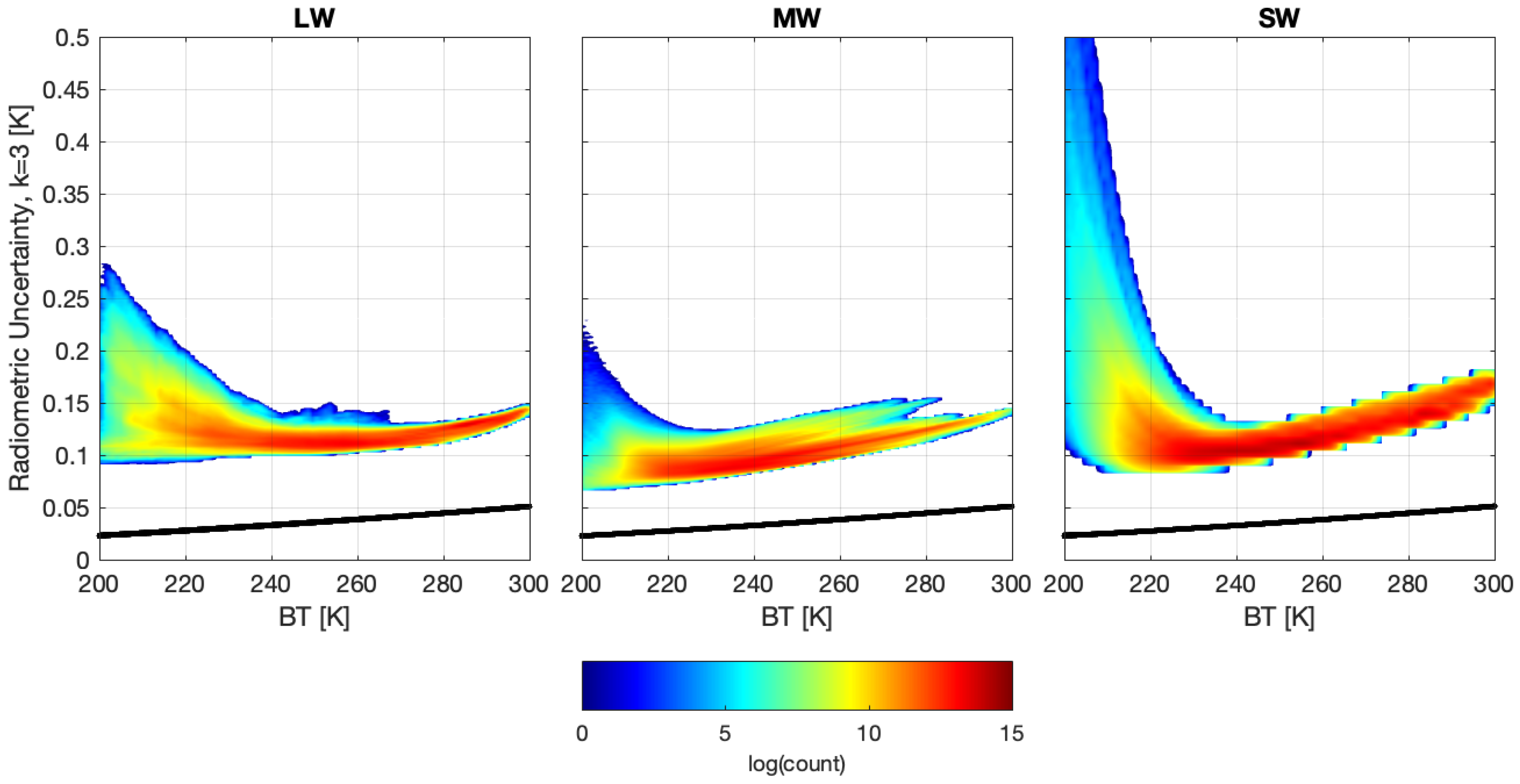

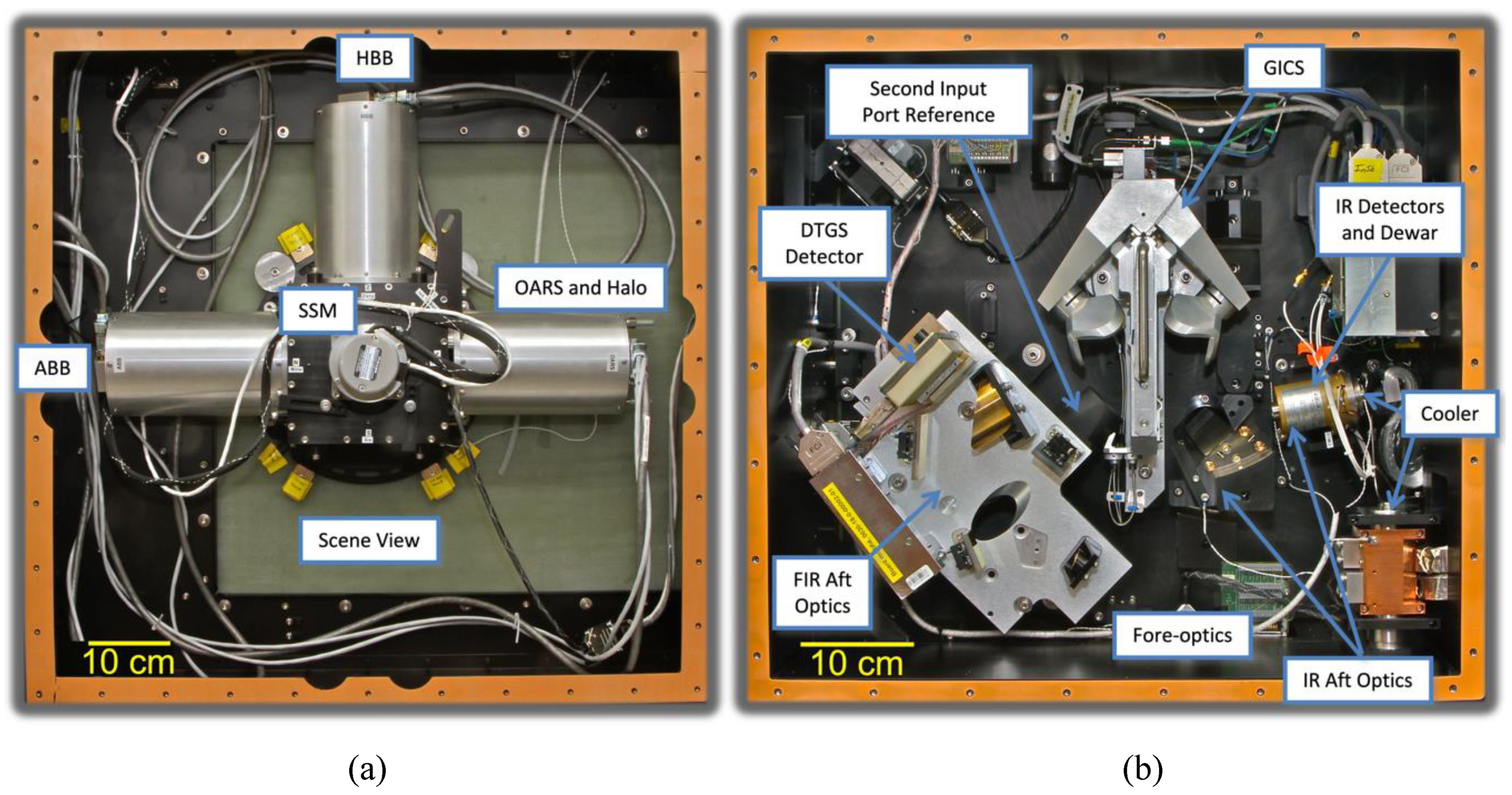
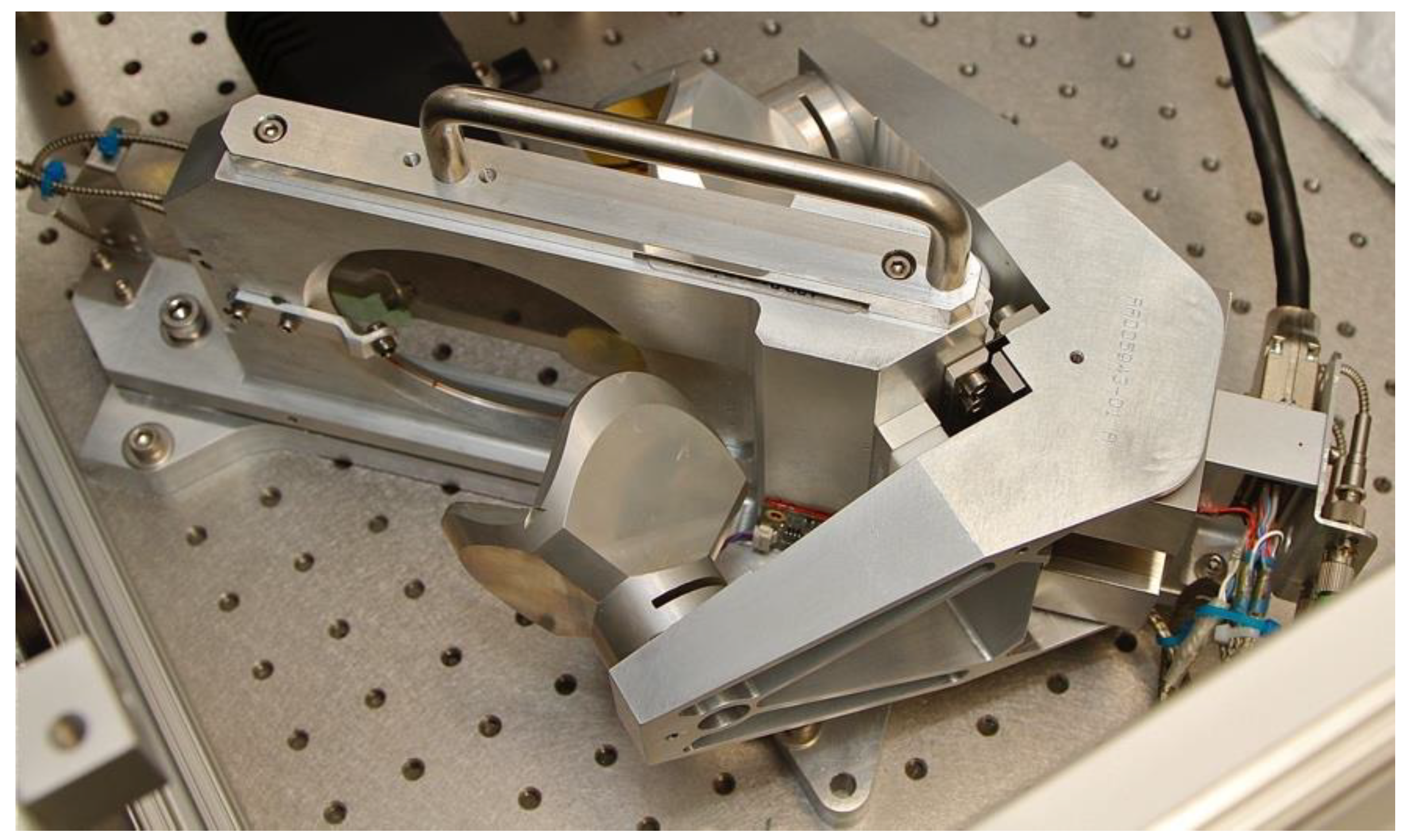
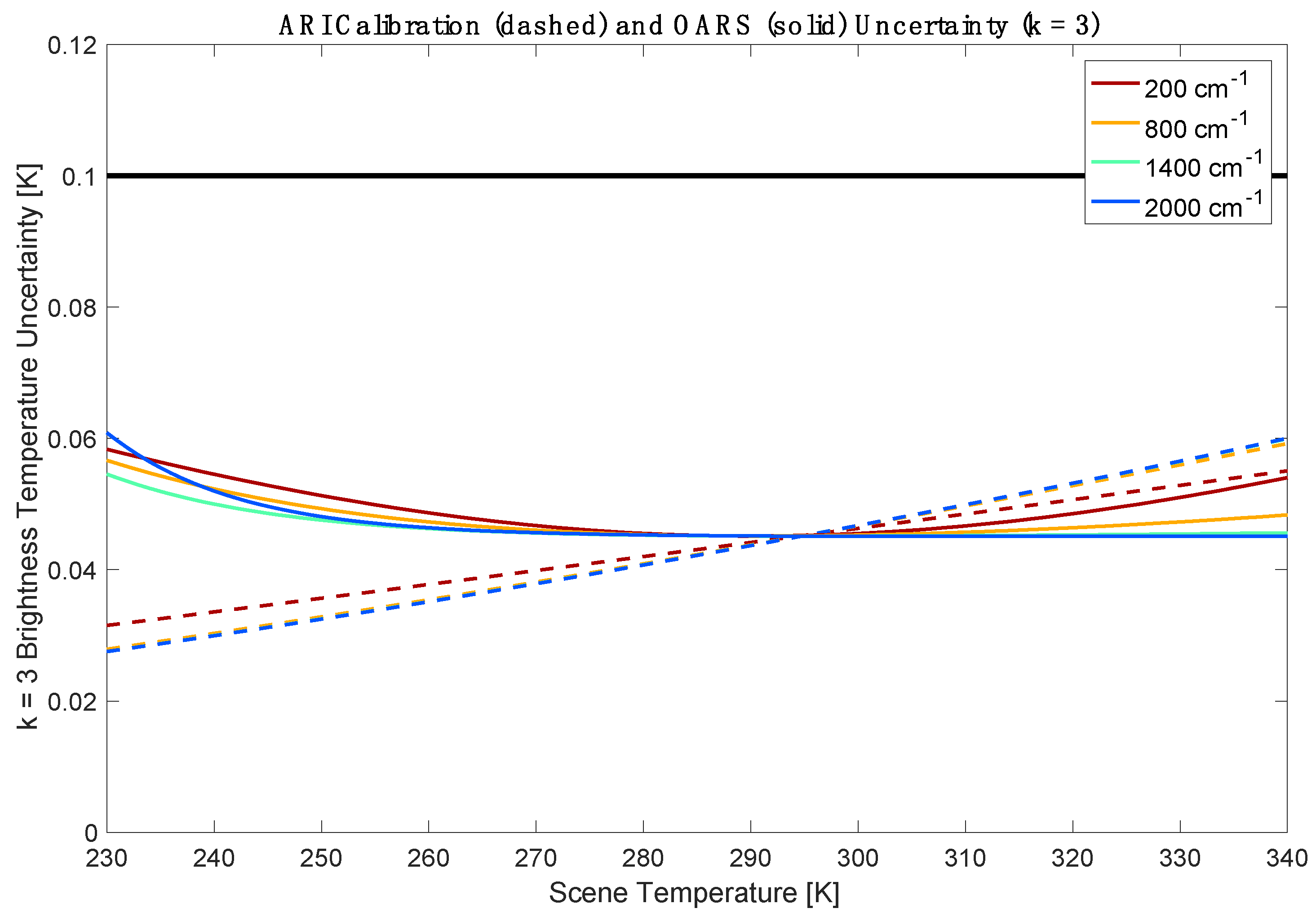
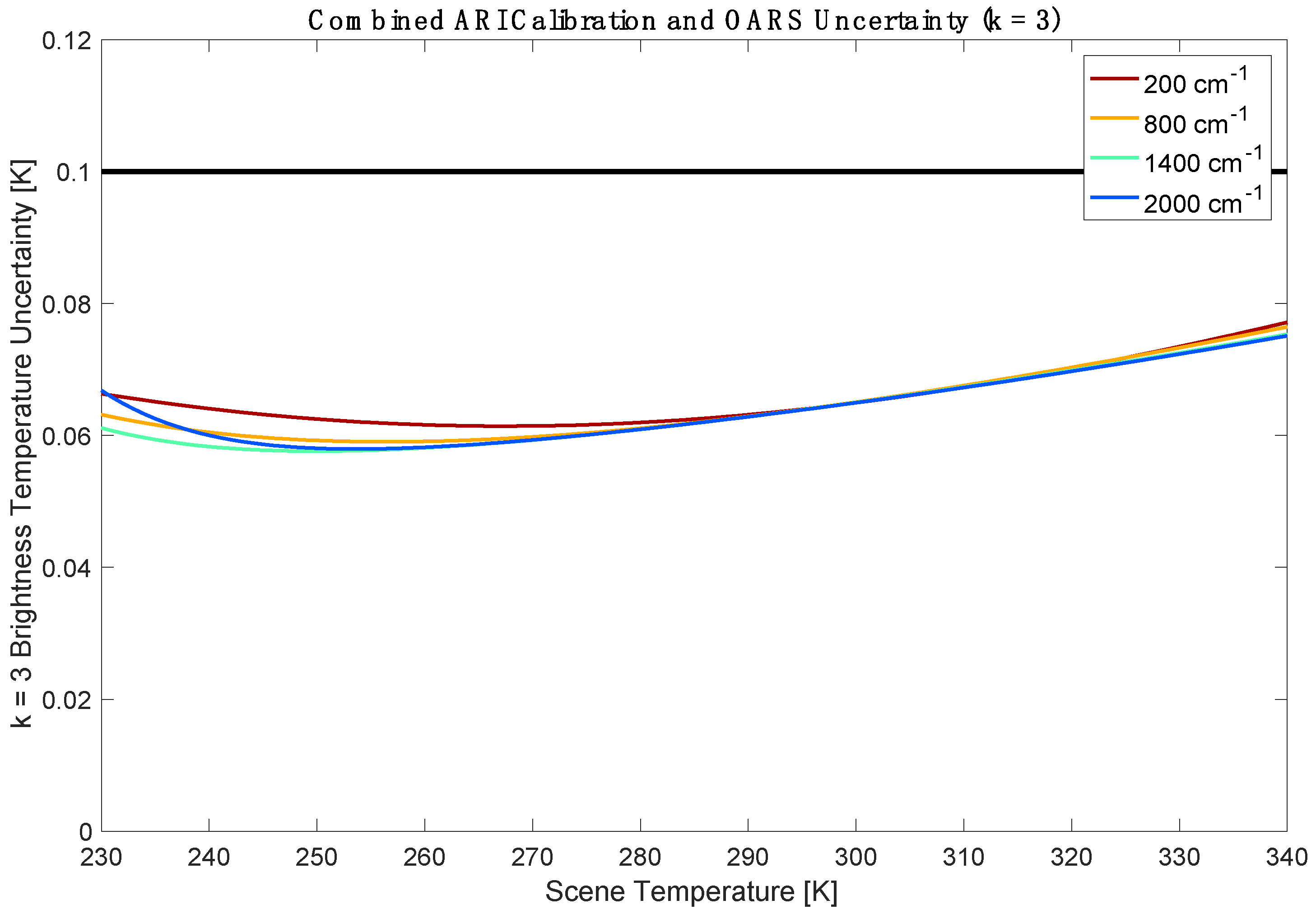


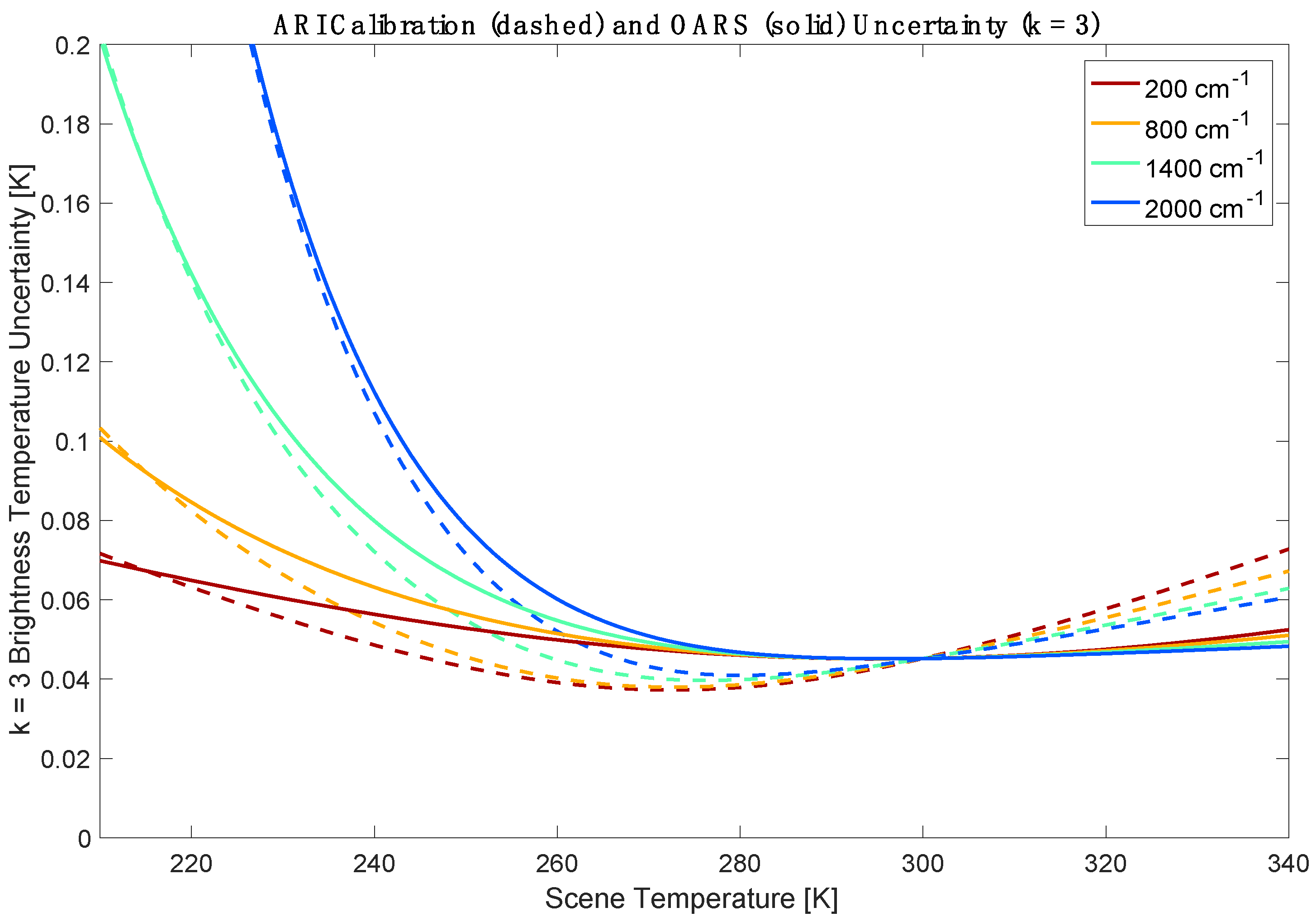
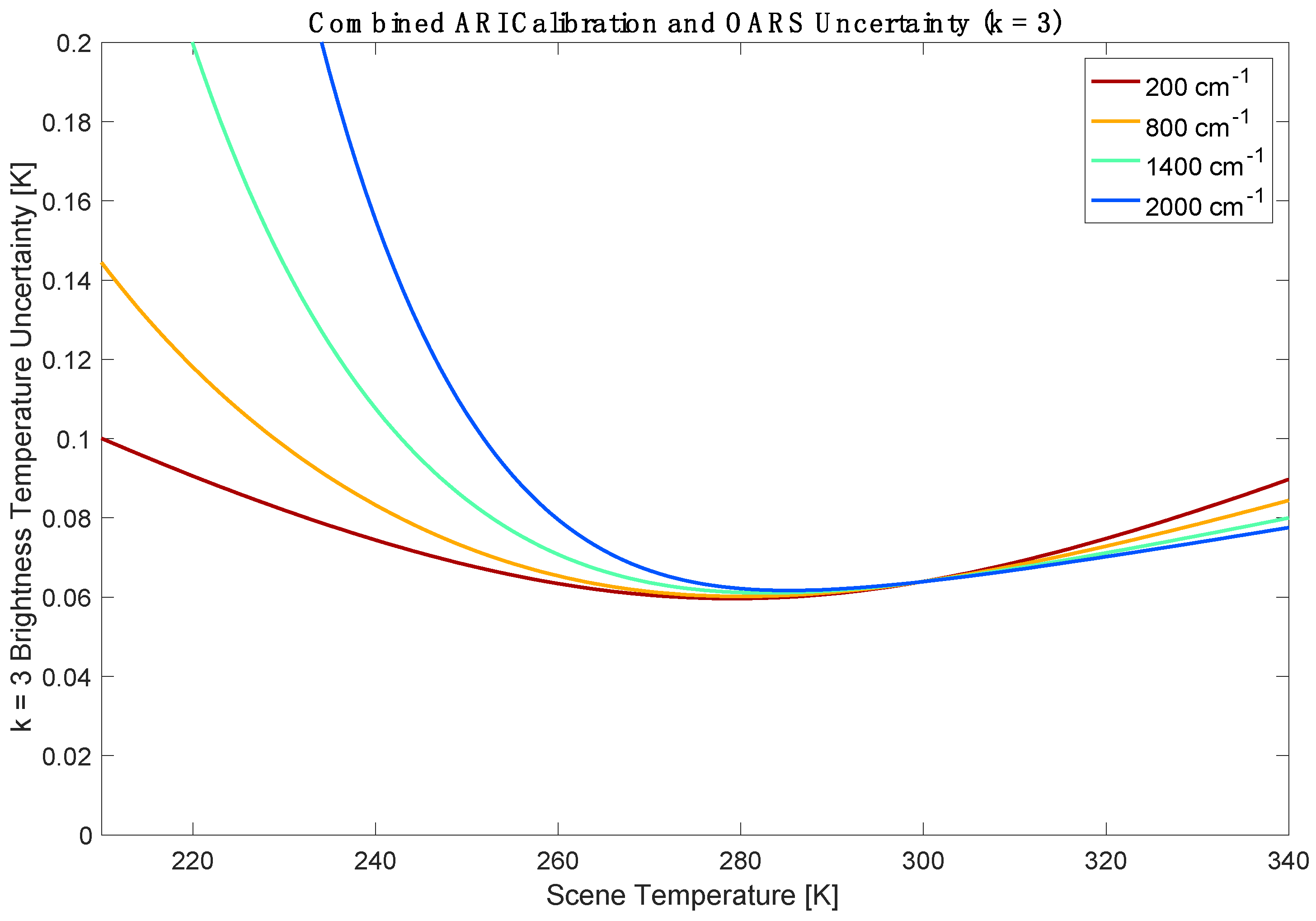


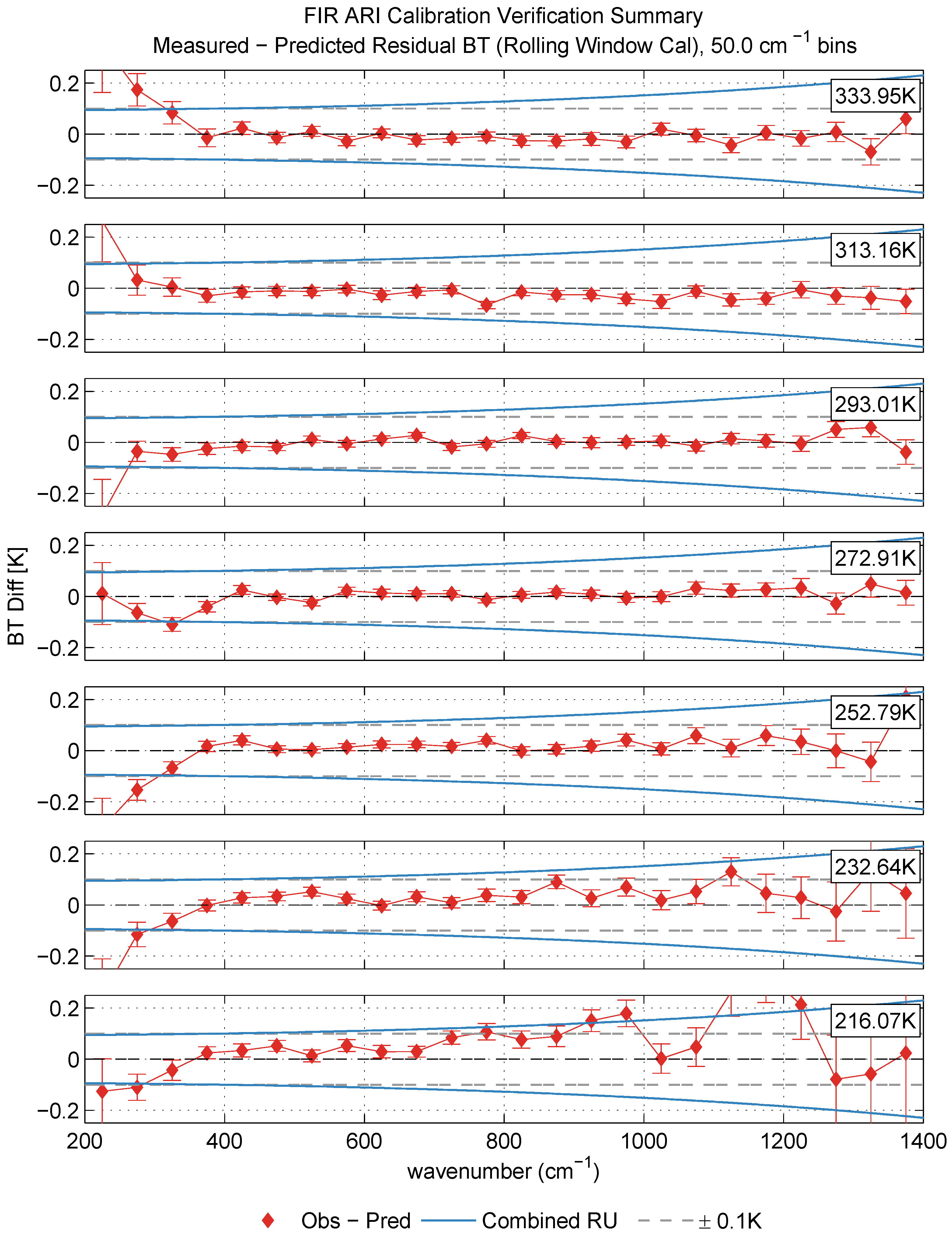
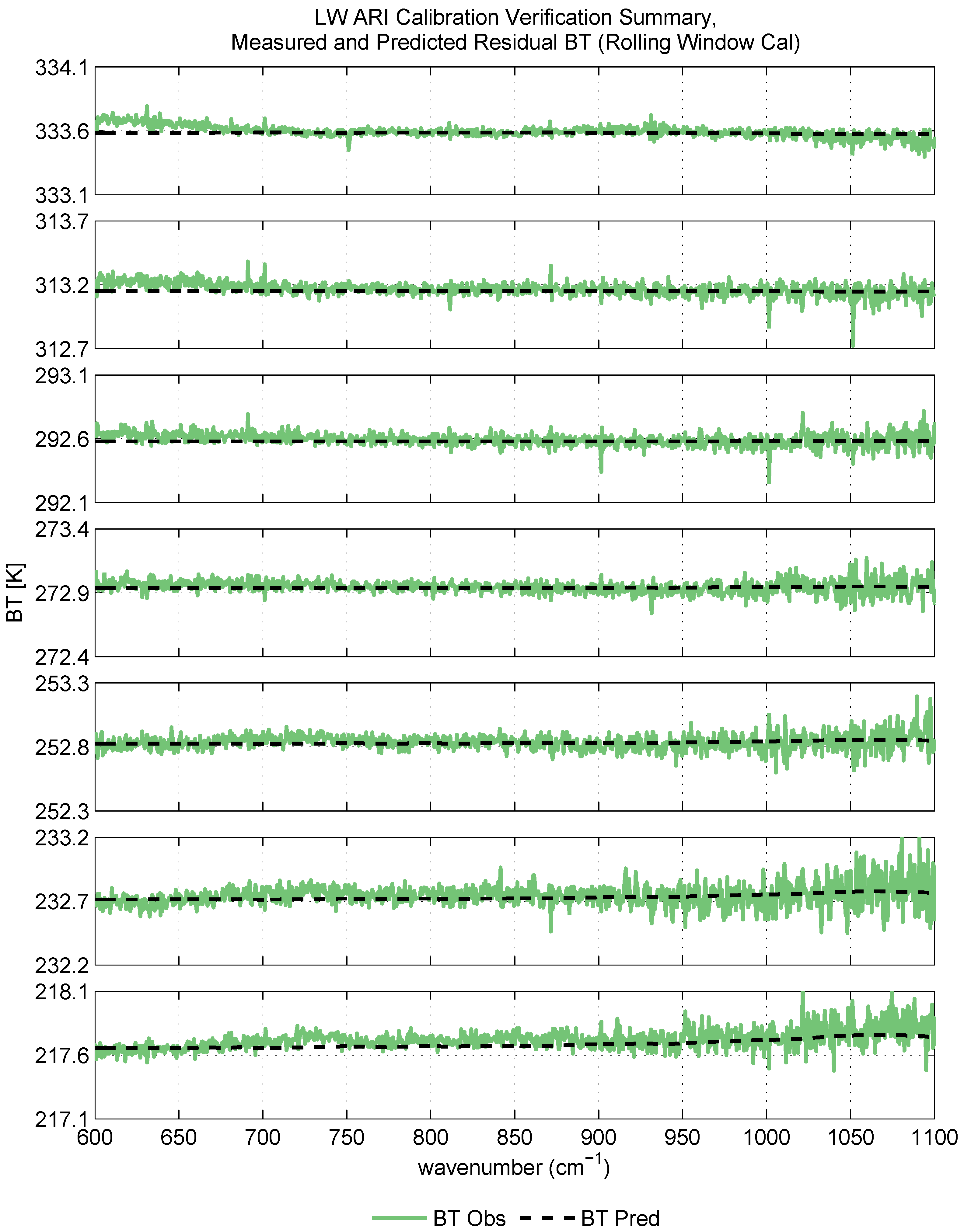

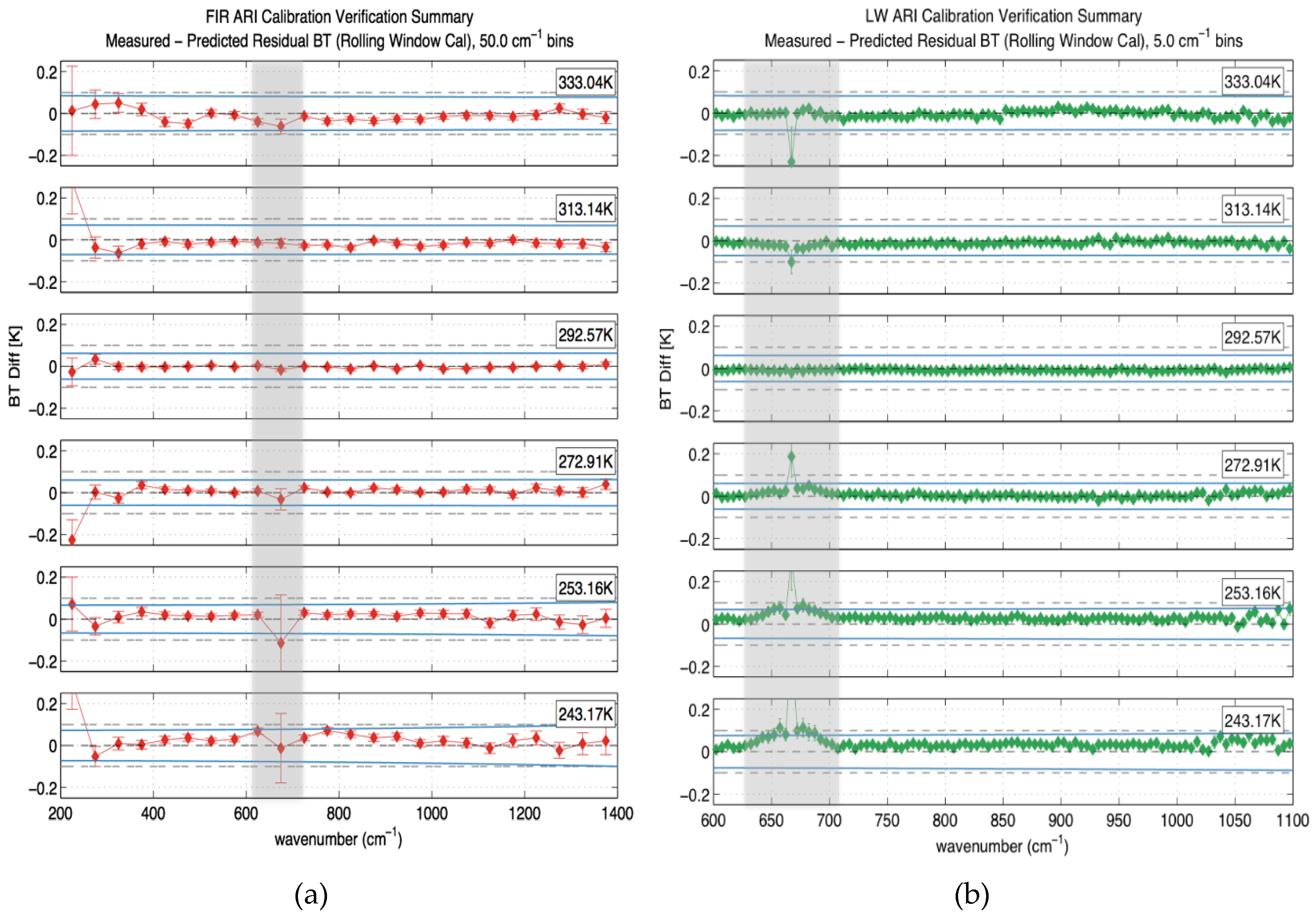
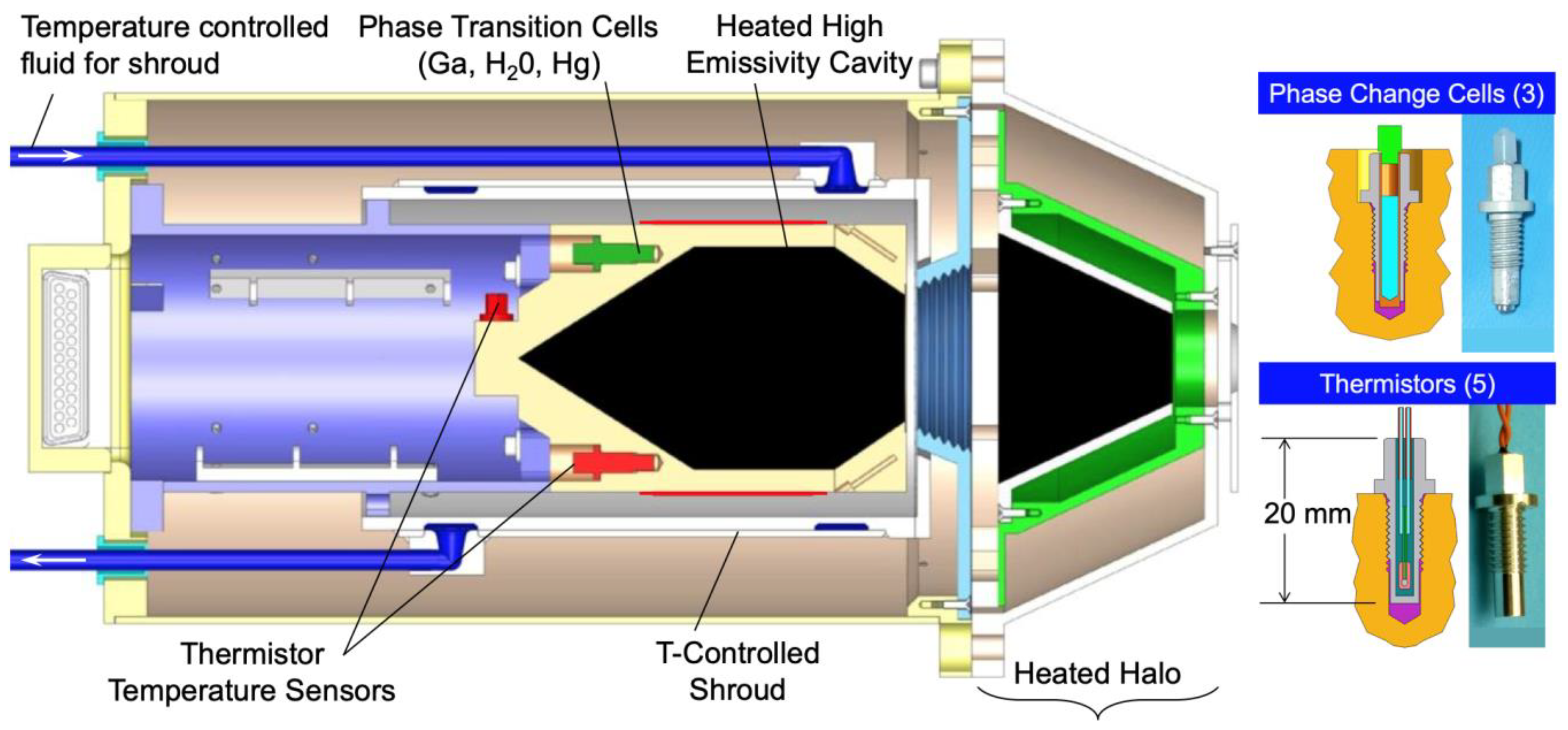

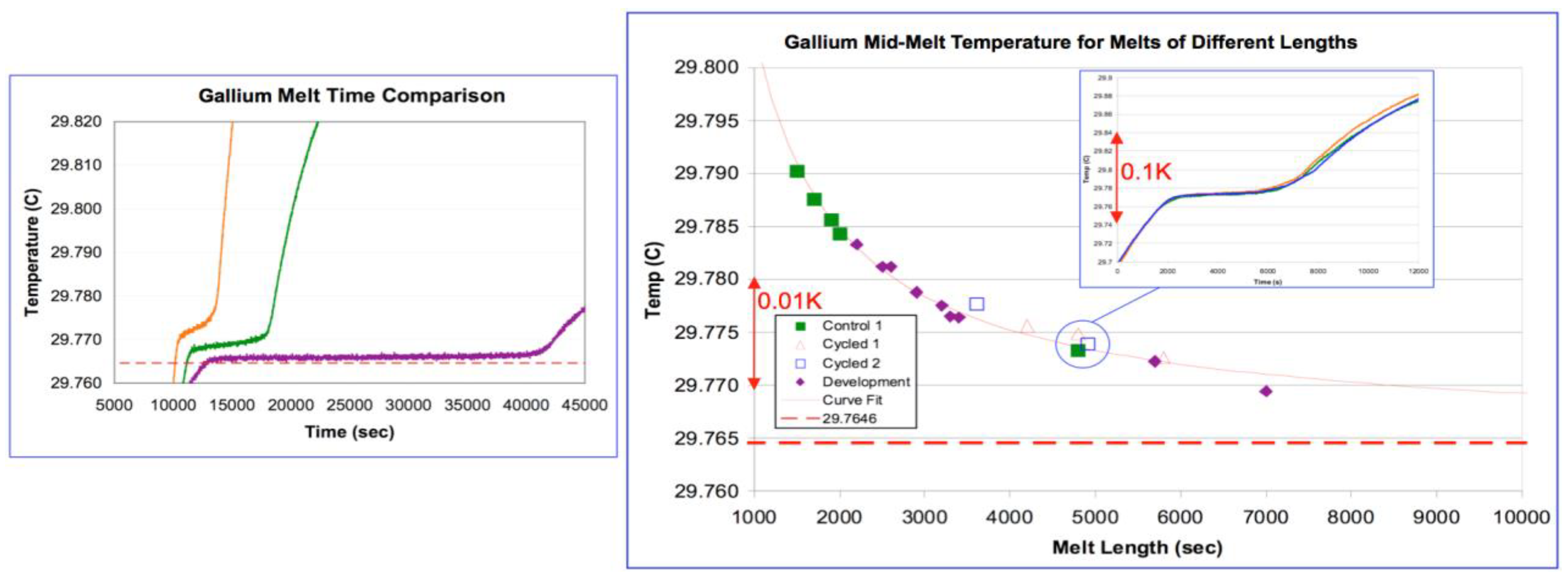

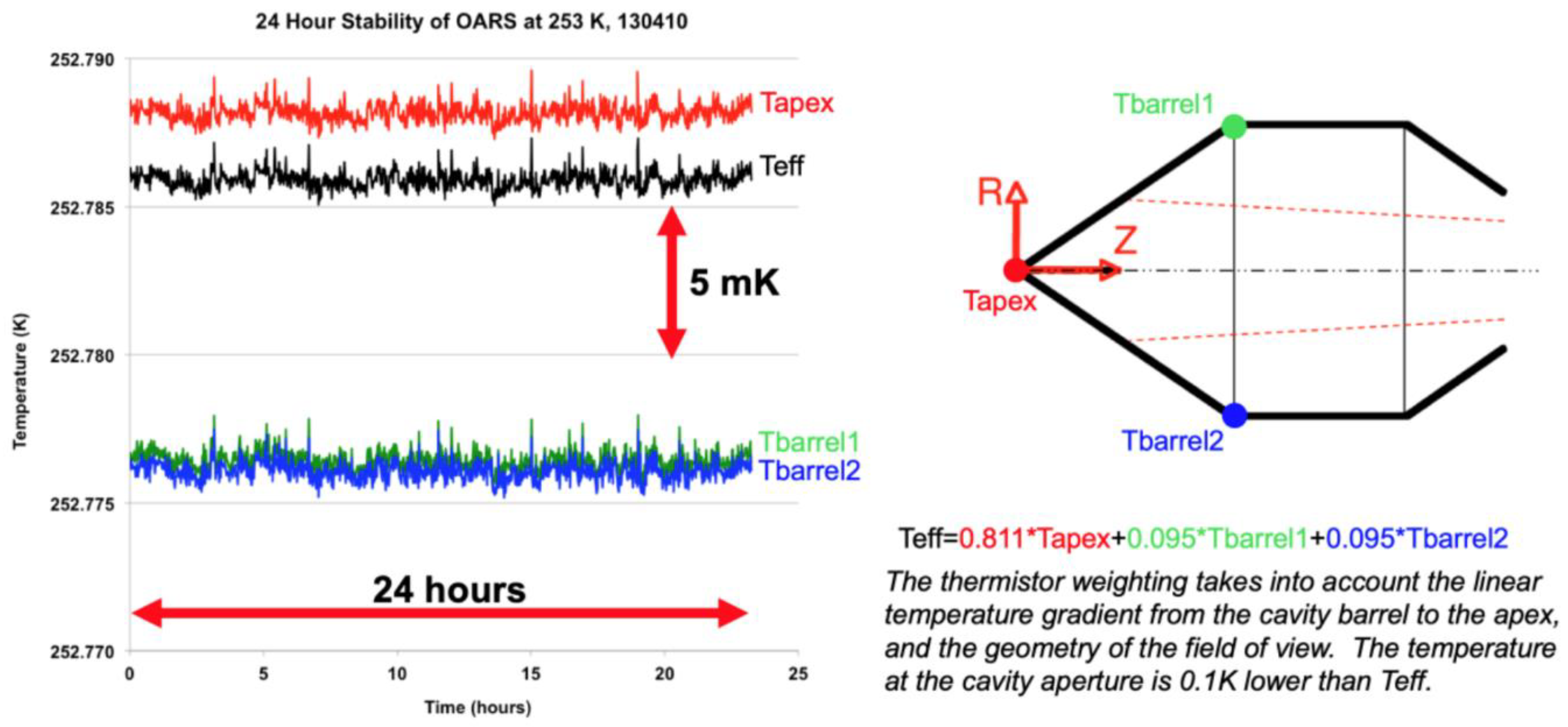

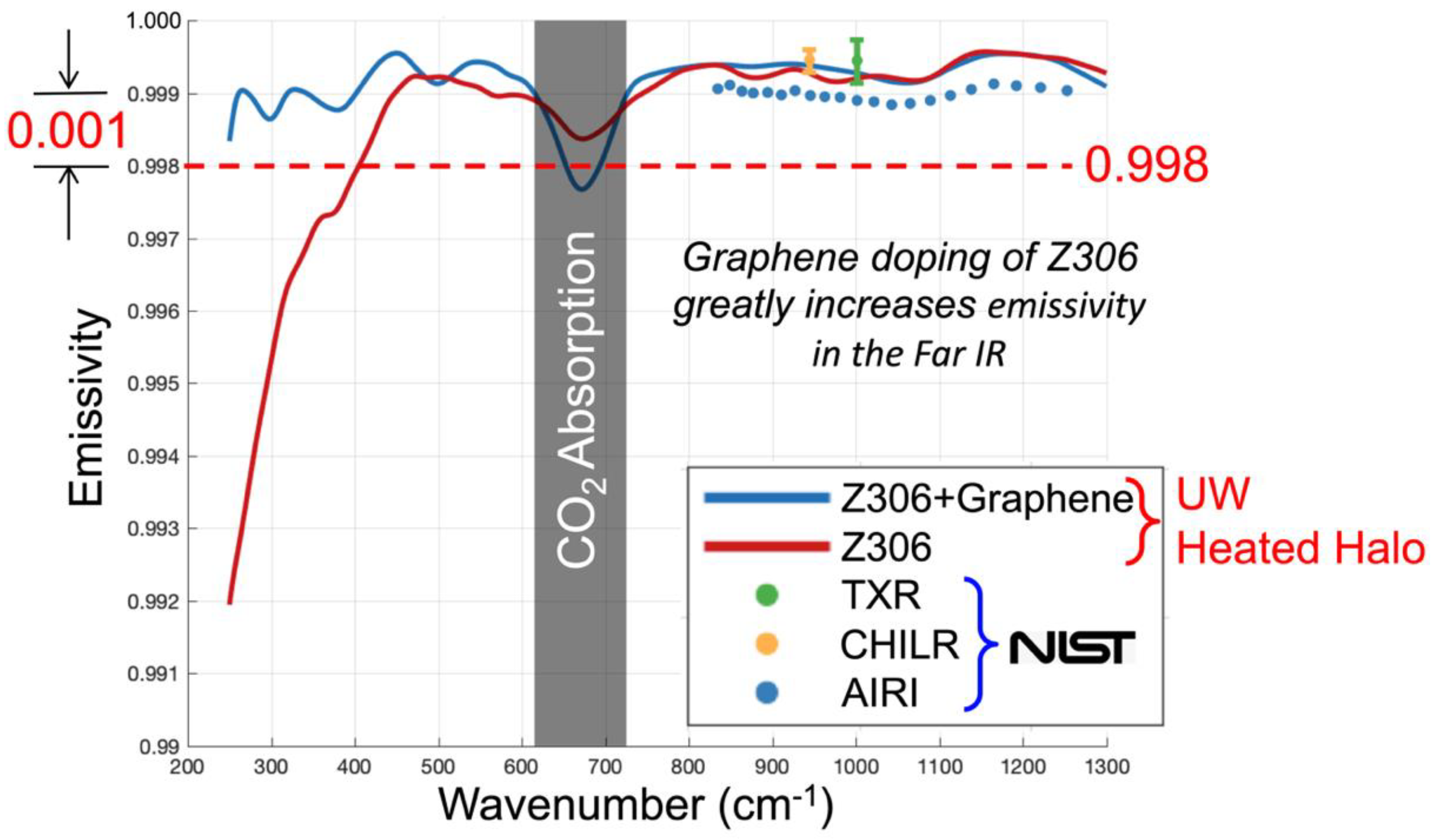
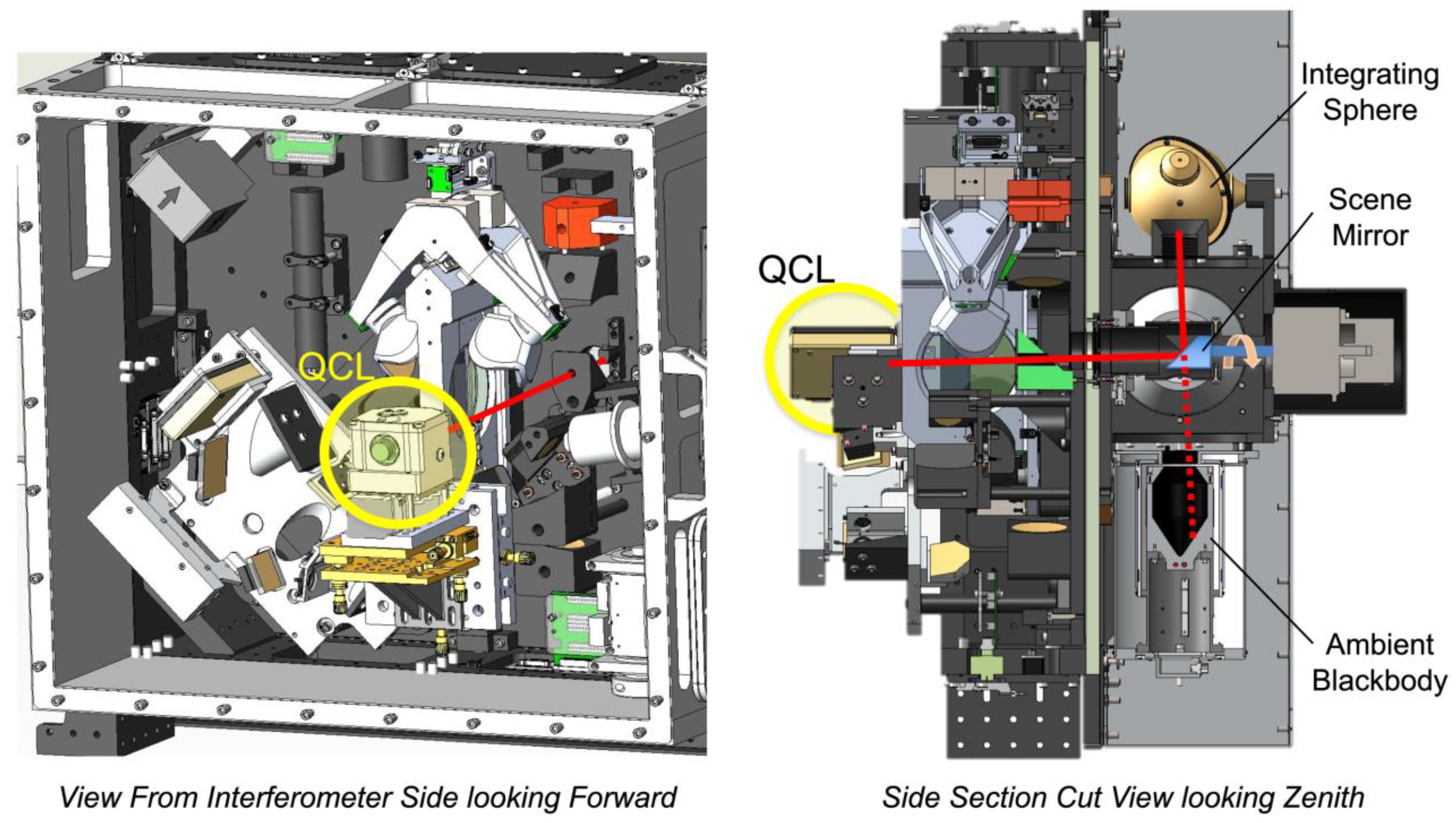



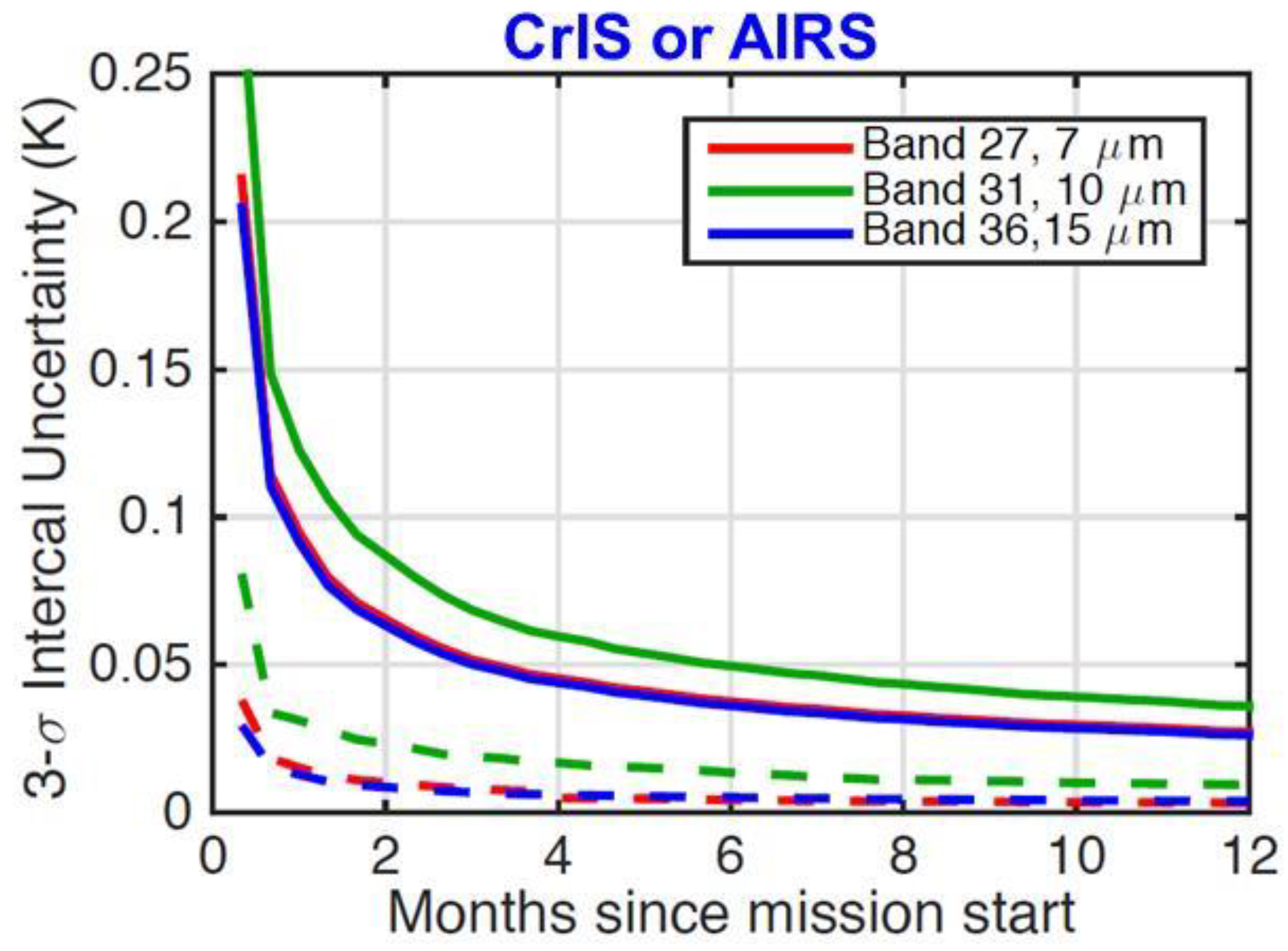
| Description | Value |
|---|---|
| Systematic Error | <0.06 K (k = 2) |
| Spectral Coverage | 200–2000 cm−1 |
| Spectral Resolution | 0.5 cm−1 (unapodized) |
| NEDT | <10 K, 200–600 cm−1 <2 K 600–1600 cm−1 <10 K, >1600 cm−1 |
| Field of View Size (Nadir) | 25–100 km |
| Ground sampling distance between successive samples along the ground track | <200 km |
| Pointing | Nadir pointing with systematic error <0.2° |
| Prototype design | 4-port FTS, 76-kg mass, 124-W avg. power, 2.5 gb day−1 |
| Temperature Uncertainty [K] (3-σ) | |||
|---|---|---|---|
| Source of Error | Laboratory OARS & ARI Cal Sources | On-Orbit ARI Cal Source | On-Orbit OARS |
| Thermistor Temperature Calibration Uncertainty | |||
| Temperature Probe Standard or Melt Plateau Determination (for On-Orbit) | 0.005 | 0.005 | 0.010 |
| Transfer of T Probe or Melt Cell to Thermistor uncertainty (gradients during cal.) | 0.010 | 0.010 | 0.002 |
| Thermistor Calibration Equation Interpolation Error Between Cal. Pts. | 0.002 | 0.002 | 0.016 |
| Cavity Temperature Uniformity Uncertainty | |||
| Cavity to Thermistor Gradient Uncertainty (1/2 of max expected gradient) | 0.015 | 0.015 | 0.015 |
| Thermistor Wire Heat Leak Temperature Bias Uncertainty * | 0.020 | 0.008 | 0.020 |
| Paint Gradient (due to radiative coupling to surrounding temperatures) | 0.018 | 0.015 | 0.018 |
| Stability Between Calibrations | |||
| Blackbody Thermistor (From [42] with factor applied for configuration differences) | 0.005 | 0.010 | 0.005 |
| Blackbody Thermistor Readout Electronics | 0.001 | 0.015 | 0.005 |
| Effective Radiometric Temperature (Teff) Weighting Factor Uncertainty | |||
| Monte Carlo Ray Trace Model Uncertainty in Determining Teff | 0.030 | 0.025 | 0.025 |
| (radiometric error that accounts for non-isothermal cavity temperature) (On-Orbit cases improved due to additional modelling) | |||
| RSS Combination | 0.045 | 0.040 | 0.045 |
| Temperatures | Associated Uncertainty | |||
|---|---|---|---|---|
| Cold Cal Ref (Space Target) | 2.7 K | 0 K | ||
| Hot Cal Ref (Internal Cal Target) | 295 K | 0.045 K | ||
| Verification Target (OARS) | 230–320 K | 0.045 K | ||
| Reflected Radiance, Cold Cal Ref | 290 K | 0 K | ||
| Reflected Radiance, Hot Cal Ref | 290 K | 4 K | ||
| Reflected Radiance, Verification Target | 290 K | 4 K | ||
| Emissivities | ||||
| Cold Cal Ref (Space Target) | 1 | 0 | ||
| Hot Cal Ref (Internal Cal Target) | 0.999 | 0.0006 | ||
| Verification Target (OARS) | 0.999 | 0.0006 * | ||
| Temperatures | Associated Uncertainty | |||
|---|---|---|---|---|
| Cold Cal Ref (Ambient Cal Blackbody) | 293 K | 0.045 K | ||
| Hot Cal Ref (Hot Cal Blackbody) | 333 K | 0.045 K | ||
| Verification Target (OARS) | 213–333 K | 0.045 K | ||
| Reflected Radiance, Cold Cal Ref | 290 K | 4 K | ||
| Reflected Radiance, Hot Cal Ref | 290 K | 4 K | ||
| Reflected Radiance, Verification Target | 290 K | 4 K | ||
| Emissivities | ||||
| Cold Cal Ref (Space Target) | 0.999 | 0.0006 | ||
| Hot Cal Ref (Internal Cal Target) | 0.999 | 0.0006 | ||
| Verification Target (OARS) | 0.999 | 0.0006 | ||
| Temperatures | Associated Uncertainty | |||
|---|---|---|---|---|
| Cold Cal Ref (Cold Cal Blackbody) | 215 K | 0.045 K | ||
| Hot Cal Ref (Warm Cal Blackbody) | 300 K | 0.045 K | ||
| Verification Target (OARS) | 213–333 K | 0.045 K | ||
| Reflected Radiance, Cold Cal Ref | 295 K | 4 K | ||
| Reflected Radiance, Hot Cal Ref | 295 K | 4 K | ||
| Reflected Radiance, Verification Target | 295 K | 4 K | ||
| Emissivities | ||||
| Cold Cal Ref (Space Target) | 0.999 | 0.0006 | ||
| Hot Cal Ref (Internal Cal Target) | 0.999 | 0.0006 | ||
| Verification Target (OARS) | 0.999 | 0.0006 | ||
| Source of Error | Temperature Uncertainty [K] (3-σ) |
|---|---|
| Thermistor Temperature Calibration Uncertainty | |
| Melt Plateau Determination | 0.010 |
| Transfer of Melt Cell to Thermistor Uncertainty (gradients during cal.) | 0.002 |
| Thermistor Calibration Equation Interpolation Error Between Cal. Pts. | 0.016 |
| Cavity Temperature Uniformity Uncertainty | |
| Cavity to Thermistor Gradient Uncertainty (1/2 of max expected gradient) | 0.015 |
| Thermistor Wire Heat Leak Temperature Bias Uncertainty * | 0.020 |
| Paint Gradient (due to radiative coupling to surrounding temperatures) | 0.018 |
| Stablilty Between Calibrations | |
| Blackbody Thermistor (From [42] with factor applied for configuration differences) | 0.005 |
| Blackbody Thermistor Readout Electronics | 0.005 |
| Effective Radiometric Temperature (Teff) Weighting Factor Uncertainty | |
| Monte Carlo Ray Trace Model Uncertainty in Determining Teff | 0.025 |
| (radiometric error that accounts for non-isothermal cavty temperature) (On-Orbit cases improved due to additional modelling) | |
| RSS Combination | 0.045 |
© 2020 by the authors. Licensee MDPI, Basel, Switzerland. This article is an open access article distributed under the terms and conditions of the Creative Commons Attribution (CC BY) license (http://creativecommons.org/licenses/by/4.0/).
Share and Cite
Taylor, J.K.; Revercomb, H.E.; Best, F.A.; Tobin, D.C.; Gero, P.J. The Infrared Absolute Radiance Interferometer (ARI) for CLARREO. Remote Sens. 2020, 12, 1915. https://doi.org/10.3390/rs12121915
Taylor JK, Revercomb HE, Best FA, Tobin DC, Gero PJ. The Infrared Absolute Radiance Interferometer (ARI) for CLARREO. Remote Sensing. 2020; 12(12):1915. https://doi.org/10.3390/rs12121915
Chicago/Turabian StyleTaylor, Joe K., Henry E. Revercomb, Fred A. Best, David C. Tobin, and P. Jonathan Gero. 2020. "The Infrared Absolute Radiance Interferometer (ARI) for CLARREO" Remote Sensing 12, no. 12: 1915. https://doi.org/10.3390/rs12121915
APA StyleTaylor, J. K., Revercomb, H. E., Best, F. A., Tobin, D. C., & Gero, P. J. (2020). The Infrared Absolute Radiance Interferometer (ARI) for CLARREO. Remote Sensing, 12(12), 1915. https://doi.org/10.3390/rs12121915




